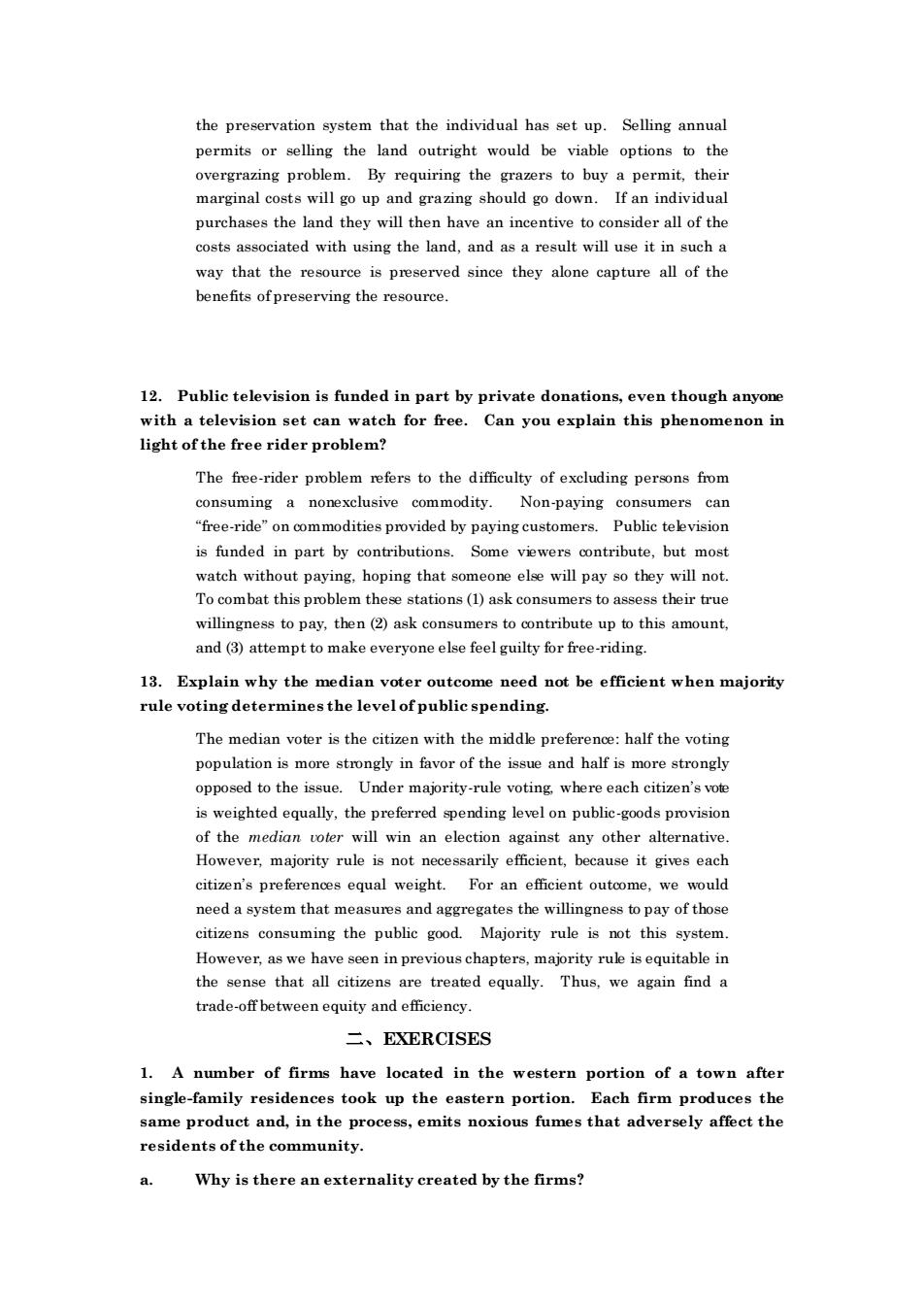正在加载图片...

the preservation system that the individual has set up.Selling annual permits o ing the land outright would be viable options the overgrazing problem.By requiring the grazers to buy a permit,thei marginal costs will go up and grazing should go down.If an individual purchases the land they will then have an incentive to consider all of the costs associated with using the land.and as a result will use it in such a way that the resource is preserved since they alone capture all of the benefits of preserving the resource 12.Public television is funded in part by private donations,even though anyone with a television set can watch for free.Can you explain this phenomenon in light of the free rider problem? The free-rider pmoblem refers to the difficulty of excluding persons from consuming a nopexclusive commodity.Non-paving consumers can Public tevision is funded in part by contributions.Some viewers contribute,but most watch without paying.hoping that someone else will pay so they will not. To combat this pmoblem these stations (1)ask consumers to assess their true willingness to pav.then (2)ask consumers to contribute up to this amount. and(3)attempttomake everyone else feel guilty for free-riding. 13.Explain why the median voter outcome need not be efficient when majority rule voting determines the level of public spending. The median voter is the citizen with the middle preference:half the voting population is more strongly in favor of the issue and half is more strongly opposed to the issue.Under majority-rule voting where each citizen's vote is weighted equally.the preferred spending level on public-goods provision of the median toter will win an election any other alter However, ajority rule s not n rily effic nt,b cause it gives each citizen's preferences equal weight.For an efficient outcome,we would need a system that measures and aggregates the willingness to pay of those citizens consuming the public good.Majority rule is not this system. However,as we have n in previous chapt th that all dt treated ally ,we aga山 trade-off between equity and efficiency 二、EXERCISES 1.A number of firms have located in the western portion of a town afte single-family residences took up the eastern portion.Each firm produces the same product and,in the process,emits noxious fumes that adversely affect the residents of the communitv. Why is there an externality created by the firms?the preservation system that the individual has set up. Selling annual permits or selling the land outright would be viable options to the overgrazing problem. By requiring the grazers to buy a permit, their marginal costs will go up and grazing should go down. If an individual purchases the land they will then have an incentive to consider all of the costs associated with using the land, and as a result will use it in such a way that the resource is preserved since they alone capture all of the benefits of preserving the resource. 12. Public television is funded in part by private donations, even though anyone with a television set can watch for free. Can you explain this phenomenon in light of the free rider problem? The free-rider problem refers to the difficulty of excluding persons from consuming a nonexclusive commodity. Non-paying consumers can “free-ride” on commodities provided by paying customers. Public television is funded in part by contributions. Some viewers contribute, but most watch without paying, hoping that someone else will pay so they will not. To combat this problem these stations (1) ask consumers to assess their true willingness to pay, then (2) ask consumers to contribute up to this amount, and (3) attempt to make everyone else feel guilty for free-riding. 13. Explain why the median voter outcome need not be efficient when majority rule voting determines the level of public spending. The median voter is the citizen with the middle preference: half the voting population is more strongly in favor of the issue and half is more strongly opposed to the issue. Under majority-rule voting, where each citizen’s vote is weighted equally, the preferred spending level on public-goods provision of the median voter will win an election against any other alternative. However, majority rule is not necessarily efficient, because it gives each citizen’s preferences equal weight. For an efficient outcome, we would need a system that measures and aggregates the willingness to pay of those citizens consuming the public good. Majority rule is not this system. However, as we have seen in previous chapters, majority rule is equitable in the sense that all citizens are treated equally. Thus, we again find a trade-off between equity and efficiency. 二、EXERCISES 1. A number of firms have located in the western portion of a town after single-family residences took up the eastern portion. Each firm produces the same product and, in the process, emits noxious fumes that adversely affect the residents of the community. a. Why is there an externality created by the firms?